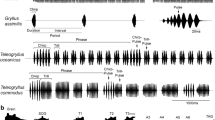Summary
-
1.
Power for both flight and for courtship song inDrosophila is provided by the indirect, myogenic, flight muscles (Fig. 7). The axillary and direct wing muscles (Fig. 1) control wing extension, most of the parameters of wing movement and the timing of song pulses. The role of these muscles during song was investigated electrophysiologically.
-
2.
Most of the axillary muscles fire during pulse song inter pulse intervals (Figs. 4, 5). It is suggested that the role of some of these muscles is to depress the wing or otherwise distort the thorax so as to stretch the dorsal ventral muscles thus initiating their contraction to produce the sound producing up-stroke of the wing.
-
3.
The basalar muscles fire synchronously with wing movements on the up-stroke of flight, sine song and pulse song (Fig. 2). The mode of action of these muscles is not clear but they are probably concerned with maintaining tension of the thoracic box and thus affect the amplitude of wing movement. They may also effect wing extension.
-
4.
The sternobasalar muscle also fires on the upstroke but only during pulse song and not sine song (Fig. 3). It is suggested that contraction of the sternobasalar muscle dampens the wing oscillation so that only single cycle pulses of sound are produced.
-
5.
Lesions of the sternobasalar muscle are accompanied by the production of polycyclic sound pulses and this supports the above hypothesis (Fig. 6).
Similar content being viewed by others
References
Bennet-Clark, H.C., Ewing, A.W.: The wing mechanism involved in the courtship ofDrosophila. J. Exp. Biol.49, 117–128 (1968)
Ewing, A.W.: The neuromuscular basis of courtship song inDrosophila: The role of the indirect flight muscles. J. comp. Physiol.119, 249–265 (1977)
Heide, G.: Flugsteuerung durch nicht-fibrilläre Flugmuskeln bei der SchmeißfliegeCalliphora. Z. vergl. Physiol.59, 456–460 (1968)
Heide, G.: Die Funktion der nicht-fibrillären Flugmuskeln vonCalliphora. Zool. Jb. Physiol.76, 87–137 (1971)
Heide, G.: The influence of wing beat synchronous feedback on the motor output system in flies. Z. Naturforsch.29b, 739–744 (1974)
Levine, J., Tracy, D.: Structure and function of the giant motorneuron ofDrosophila melanogaster. J. comp. Physiol.87, 213–235 (1973)
Mulloney, B.: Interneurons in the central nervous system of flies and the start of flight. Z. vergl. Physiol.64, 243–253 (1969)
Nachtigall, W., Wilson, D.M.: Neuro-muscular control of dipteran flight. J. Exp. Biol.47, 77–97 (1967)
Pringle, J.W.S.: Insect Flight. Cambridge: University Press 1957
Ritter, W.: The flying apparatus of the blow-fly. Smithson. Misc. Collect.56, 1–77 (1911)
Williams, C.M., Williams, M.V.: The flight muscles ofDrosophila repleta. J. Morphol.72, 589–597 (1943)
Author information
Authors and Affiliations
Rights and permissions
About this article
Cite this article
Ewing, A.W. The neuromuscular basis of courtship song inDrosophila: The role of the direct and axillary wing muscles. J. Comp. Physiol. 130, 87–93 (1979). https://doi.org/10.1007/BF02582977
Accepted:
Issue Date:
DOI: https://doi.org/10.1007/BF02582977




